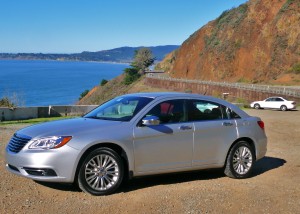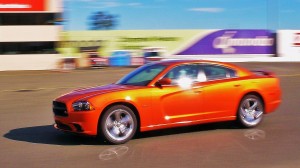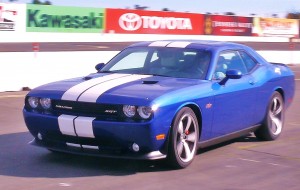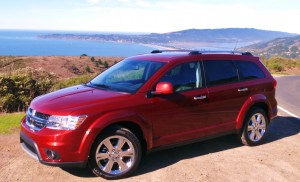Fiat helps Dodge, Chrysler get new life for 2011
By John Gilbert
What seems like identity-crisis time for Chrysler and Dodge may be the dawn of a promising upside. Getting through the transition of being purchased by Italy’s Fiat conglomerate, Dodge and Chrysler could see immediate benefits, based on the introduction of their revised fleet of vehicles for 2011.
The words style and refinement haven’t often been used favorably to describe Chrysler or Dodge vehicles recently, and, except for minivans, it’s been years since anyone pointed to anything from the corporation as a standard of interior finish and style. But everything in the Chrysler line, and almost everything behind a Dodge nameplate is revised and improved for 2011. Some of the products, such as the Dodge Grand Caravan or the Chrysler Town & Country, don’t look all that different, but whether the sheet metal is changed or not, the engines, drivetrains, structure, and suspension have been changed and vastly improved in every model.
When you consider it, the union of Fiat with ChryslerDodge/Jeep is a natural. Fiat wanted to return to the U.S. market, but lacked a nationwide network. Chrysler needed a truly competitive small car, and Fiat has the 500, a tiny but strong global commuter car. Chrysler, LLC, needed financial backing, and Fiat has money. But nobody anticipated the instant changeover that appears to have taken place.
Fiat is bringing its 500 minicar to the U.S. as a separate entity, at $15,000, so it really wasn’t part of the wholesale overhaul of the Chrysler and Dodge products shown to auto journalists in the Napa Valley area of California in November. Nor was the new Chrysler 300 part of the scene, presumably holding back what is anticipated to be a rebodied Lancia sedan until January and the Detroit International Auto Show.
An exceptional new V6 engine is at the base of the renovation, but the most tangible feature to attract consumers will be new and well-designed interiors. Gone are the rock-hard plastic panels that could often be as guilty of rattling as they were easy to appear misaligned. In their place will be softer surfaces, pleasing to the touch and the eye. My favorite example is that I always admire well-designed steering wheels. The simple but efficient style of a good three-spoke wheel, with logical placement of ergonomic switchwork, and a fairly thick, substantial gripping area, always impress anyone who slided into the driver’s seat. In any Dodge, however, we’ve had to tolerate a large, four-spoke wheel that always seemed to be barely adequate. Well, those stodgy steering wheels are gone, and new ones have magically appeared in their place.
We will credit Fiat’s Italian eye for style for such improvements, but of course the new vehicles go well beyond that. The new Chrysler 200 is a quantum leap up from the Sebring, although its more stylish grille and silhouette seems to still carry a hint of the Sebring’s rear bulkiness. The Town & Country van, impressively redone just a couple of years ago, gets a thorough interior makeover, which makes a good family hauler even more family-friendly, and includes a huge rear panoramic video screen above its stow-and-go second and third row seats, and a “UConnect” system that not only allows voice commands, but can turn the T&C into a personal Wi-Fi station.
Chrysler engineers benchmarked the redoubtable BMW 5-Series for suspension revisions, and Lexus models for reducing noise and harshness. Under Fiat direction, nobody is saying the Chrysler models will challenge BMW 5s or the top Lexus vehicles, but if you can match the vehicles considered best in various elements, your new-life Chryslers will be heading down the right roads.
At Dodge, the Grand Caravan gets similar treatment, and the Avenger is restyled into a neat, four-door midsize sedan. The Charger gets total revision too, and the Challenger adds some new power at both ends of the spectrum, as well as adding exterior tweaks and interior upgrades. The Durango, which went away a couple of years ago ahead of the demise of large SUVs, returns with functional upgrades. And the Journey, a greatly overlooked compromise between minivans, SUVs and crossovers, gets similar improvements.
All of the new cars from Dodge and Chrysler are, as they say in the auto biz, refined and restyled, and they move into the high-tech world of engines with availability of a new Pentastar 3.6-liter V6, which becomes the main upgraded engine for just about everything.
Jeep, also owned by Chrysler, is no problem. The popular off-road icon started off the new vehicle parade with an impressive new Grand Cherokee. Always a popular family wagon, the new Grand Cherokee is a completely refined and subtly restyled vehicle that might be the best example of the glass being half-full. While the new Grand Cherokee requires a more full review, it adds a new dimension to the “crossover” designation, because instead of being the first vehicle from Chrysler-Dodge-Jeep to feel the fine hand of Fiat, the Grand Cherokee instead benefits from being the last remnant of previous owner Mercedes Benz.
The German purveyor of fine vehicles has made some stout SUVs in recent years, and the Mercedes ML320 has risen to high standards as an agile and versatile SUV. It is that platform that remains underpinning the new Grand Cherokee. The other subtle feature is that while the Grand Cherokee again boasts of the powerful Hemi V8 engine, the more basic, and logical, engine powering it is the entirely new Pentastar V6 built by Chrysler — a 3.6-liter gem with dual overhead camshafts and sophisticated engineering that is long overdue from the corporation.
The Hemi pushrods push out an impressive 360 horsepower and 390 foot-pounds of trailer-towing torque, but the Pentastar V6 offers a solid 290 horsepower and 260 foot-pounds — more than adequate for almost any venture a Grand Cherokee owner might undertake. For decades, Chrysler Corporation sputtered along with band-aid-fix V6 engines, including a promising but undeveloped 2.8-liter, a 3.0, 3.1, 3.3, 3.5, 3.8 and 4.0, and maybe a few other numbers long forgotten. None of them was really impressive, in technology or performance or competitiveness, and all of them seemed like temporary fixes while a real high-tech engine must be under construction. It wasn’t, until now. The new 3.6 replaces all seven of those easily forgotten engines, and it outperforms all of them.
Styling makes some bold moves, with most of them wearing a redone “cross-hairs” grille, as the trademark steps off in a new direction. The Avenger grows up, into a sporty cousin of Chrysler’s new 200, while the Charger gets new styling that features a sculptured side indent. The Durango returns from extinction as, essentially, a stretched out Grand Cherokee, now with unibody construction housing room for three rows of seats.
We were able to test drive the cars on mountain highways outside of San Francisco, and at Infineon Raceway, which used to be known as Sears Point. The various vehicles lived up to claims about being improved in appearance on the outside, greatly improved on the inside, and ride quality has benefitted vastly by altering almost every suspension component. The improvement in stability and smoothness can only be listed under that “refined” catch-all. Improved steering components, at the other end of those new steering wheels, directs the cars, vans and SUVs to respond quickly while staying well planted in tight turns. The other prime area of improvement is in “NVH” — noise, vibration and harshness. Every model we drove exhibited more exacting fits of panel seams, and we commented several times about how greatly reduced the interior noise-levels are against intrusion from wind or road irregularities.
There will be more differentiation between Chrysler and Dodge vehicles, with Dodge going for sportier and more performance ideas, and Chrysler trying to reestablish itself with an entry-luxury array. In that regard, the Dodge Grand Caravan is aimed at staying at or below $30,000, while 50 percent of Chrysler Town & Country buyers will spend over $30,000 for a family hauler bristling with more creature features.
Dodge’s focus on performance sent us to Infineon Raceway for some hot laps in the Challenger and Charger, including the Hemi-powered R/T models. The Challenger adds a new 392 Hemi model, with the number matching the size and numerical nickname of the first high-performance Hemi that was successfully raced on major dragstrips in the 1970s. Big Daddy Don Garlits drove to Top Fuel fame with dragsters using a 392, and legendary drag-race engine-builder Keith Black made his name by modifying those 392s into the race engines that powered Don (the Snake) Prudhomme and virtually every other Top Fuel and Funny Car contender.
It was fun flinging the 392 Hemi Challenger around Infineon’s twisty track, but I also was impressed when I took the V6 Challenger out for a brief ride on roads curving through the nearby hillsides. With its suspension revisions stiffening the ride and the quickened handling response, my favorite of the new Challengers is the base car, armed with the Pentastar V6. The engine is 46 pounds lighter than the V6 it replaces, but delivers 55 more horsepower — at 305, peaking at 6,350 RPMs. It is a true world-class competitor for the new 3.7 V6 Mustang, even if it is not similarly available with a stick shift.
If the base Pentastar V6 can impress even a performance enthusiast in the Challenger, the corporation’s familiar ad campaign may have to be revised, too. You know, the one where the guy says, “That thing got a Hemi in it?” The answer now might be: “No, I’ve got a Pentastar V6,” which could still earn a thumbs-up, even from a red-neck country boy.
That Pentastar V6 engine will give both Dodge and Chrysler the chance to make an immediate impression on any test-driver in any vehicle. It works well in all of them, enlivening the Journey and all of the sedans, and most notably as the only engine available in either minivan. It also is fully adequate even in the full-side SUV Durango, where it can tow 6,200 pounds — better than the previous Durango with the 4.7-liter V8.
The sweeping overhaul of everything in the line caused one humorous exchange. We were driving various vehicles through the mountains. We already had been in the cars, and now we were going through the Dodge Journey, which is a favorite of mine, plus the revised minivans, and the surprising Durango. When we stopped for a driver change, I pulled off the main road and parked on a side road by the designated coffee shop. As we walked around to the front of the building, I spotted a vehicle that was visible from the windshield on back. I stopped my partner, and asked him if he could readily identify whether it was a Grand Caravan, a Journey, or a Durango. He hesitated, then he had to laugh. There was no way to tell.
Once inside, or after measuring, there are significant differences in all three, of course. But the impression at a glance shows consumers shouldn’t be guilty of tunnel-vision. The overlooked vehicle in the adjacent slot at the dealership might actually be better suited to your needs, because variations can be found in performance, handling and fuel economy — although that new V6 will be a great equalizer. The assembled fleet indicates that skepticism about Fiat ownership has been replaced, because Dodge and Chrysler have raised the potential of their entire line of people-haulers.
Comments
Tell me what you're thinking...
and oh, if you want a pic to show with your comment, go get a gravatar!







 John Gilbert is a lifetime Minnesotan and career journalist, specializing in cars and sports during and since spending 30 years at the Minneapolis Tribune, now the Star Tribune. More recently, he has continued translating the high-tech world of autos and sharing his passionate insights as a freelance writer/photographer/broadcaster. A member of the prestigious North American Car and Truck of the Year jury since 1993. John can be heard Monday-Friday from 9-11am on 610 KDAL(www.kdal610.com) on the "John Gilbert Show," and writes a column in the Duluth Reader.
John Gilbert is a lifetime Minnesotan and career journalist, specializing in cars and sports during and since spending 30 years at the Minneapolis Tribune, now the Star Tribune. More recently, he has continued translating the high-tech world of autos and sharing his passionate insights as a freelance writer/photographer/broadcaster. A member of the prestigious North American Car and Truck of the Year jury since 1993. John can be heard Monday-Friday from 9-11am on 610 KDAL(www.kdal610.com) on the "John Gilbert Show," and writes a column in the Duluth Reader.